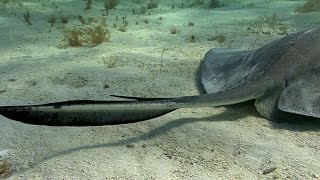Next on Jonathan Bird's Blue World, a look at the amazing ways animals in the ocean cleverly defend themselves against predators!
接下来请收看乔纳森·伯德的《蓝色世界》,我们来看看海洋中的动物如何巧妙地保护自己免受捕食者的攻击!
Hi, I'm Jonathan Bird and welcome to my world!
嗨,我是乔纳森·伯德,欢迎来到我的世界!
The ocean is a tough environment to live. To survive, every animal must eat, and that means that other animals get eaten.
海洋是个艰难的生存之地,为了生存,每只动物都必须进食,这意味着其他动物会被吃掉。
And nobody wants to get eaten! So...
谁也不想被吃掉!所以...
Animals in the ocean have come up with a lot of ways to defend themselves. They have spines, venom, speed, maneuverability and even a smoke screen.
海洋中的动物想出很多保护自己的方法,它们使用刺、毒液、速度、机动性,甚至还有烟幕。
Come check out this fish!
快来看这条鱼!
The lionfish has pretty obvious defenses—dozens of spines sticking out in all directions.
狮子鱼的防御措施很容易看出来,数十根刺伸向四面八方。
They're not only sharp, but venomous.
这些刺不仅锋利,还有毒。
Very few animals can eat a lionfish, especially when it's fully grown.
没有什么动物能吃掉狮子鱼,特别是在它长大以后。
A sting from one of these spines is extremely painful.
要让这些刺刺中的话会非常痛。
The stonefish has much less obvious spines, but they are considerably more venomous. A sting from one of these spines will send a diver to the hospital.
石头鱼的刺不那么明显,但它们的毒性要大得多。潜水员被这些刺刺中的话,就得送进医院了。
Fortunately, these well-camouflaged fish pose no threat to divers if we don't touch them.
幸运的是,如果我们不去碰这些伪装超好的鱼,它们是不会对潜水员造成威胁的。
Stingrays only have a single spine.
黄貂鱼只有一根刺。
It's located at the base of the tail, and can be pointed and jabbed at a threat from above. Since sharks love to eat stingrays, the venomous spine is used to jab sharks that come too close.
这根刺位于尾部的底部,上方出现威胁时,可以指向并刺穿威胁物。因为鲨鱼喜欢吃黄貂鱼,所以毒刺可以用来刺向靠得过近的鲨鱼。
Every once in a while an unfortunate swimmer steps on a stingray and gets stung, but for the most part, stingrays are not at all aggressive towards people.
偶尔会有不幸的游泳者踩到黄貂鱼后被叮一下,但大多数情况下,黄貂鱼对人一点也不具攻击性。
In the Cayman Islands, they are downright friendly!
在开曼群岛,它们非常友好!
Fish aren't the only animals in the ocean with spines.
鱼不是海洋中唯一带刺的动物。
Sea urchins have many sharp spines with brittle tips. If an animal gets skewered by one of these spines, the end breaks off below the skin and causes pain for months.
海胆有许多顶部易碎的尖刺,如果有动物被一根刺刺中,刺尖会在皮肤下面断裂,导致数月的疼痛。
Long-spined urchins are so well protected that sometimes small fish even use them for safety, hiding between the spines where no predator would dare trying to get them!
带有长刺的海胆受到很好的保护,有时小鱼甚至会用它们做庇护地,躲在那些刺之间,没有捕食者敢试着去捕捉它们!
Spines work so well for urchins that some of their close relatives the sea stars have spines too.
海胆的刺发挥着很好的作用,连它们的一些近亲海星也带刺。

The spines on the crown-of-thorns sea star are every bit as sharp and painful as those on an urchin.
刺冠海星的刺和海胆上的刺一样锋利,也会让被刺者非常疼痛。
Believe me, I learned that the hard way!
相信我吧,我知道那滋味啊!
Sea Cucumbers are closely related to sea urchins and sea stars.
海参与海胆、海星之间关系密切。
But most sea cucumbers have no spines at all for defense.
但大多数海参根本没有用于防御的刺。
The sea cucumber has an even more amazing--and disgusting--way of getting rid of predators! When attacked, many species of sea cucumbers eviscerate from their mouth a gooey mess called cuvierian tubules.
海参有一种更令人惊异、更令人作呕的方法来摆脱捕食者!当它受到攻击时,许多种类的海参会从口中排出一种叫做居维氏管束的粘性物质。
These sticky, stringy organs presumably give a predator something unappealing to eat, and they are often accompanied by the secretion of a poison.
这些黏稠、细密的器官可能会让捕食者觉得没兴趣吃,通常还会分泌毒素。
This combination prevents sea cucumbers from being a popular food item in the ocean!
这种组合可以避免海参成为海洋中受欢迎的食物!
The sea cucumber can retract the tubules, and replace the lost ones in a few weeks and be ready to eviscerate again!
海参能够收回这些管束,并在几周内替换掉丢失的管束,准备好下次再排出!
Some forms of defense are just simple common sense. These fish are staying within the protection of a branching coral. They feed on plankton that the current brings by, but they don't venture far from the safety of the coral.
有些防御形式很容易理解。这些鱼呆在分叉的珊瑚中,受到珊瑚的保护。它们以水流带来的浮游生物为食,但不会冒险远离珊瑚。
Other fish are too big to feed on plankton and must go out of the protection of the reef if they want to find food.
其他鱼类体型太大,无法以浮游生物为食。如果它们想找食吃,就必须离开珊瑚礁的保护。
Their defense is to keep an eye peeled and be ready to zoom into the reef if a threat comes along.
它们的防御措施是保持警觉,一旦威胁物出现,就快速游入珊瑚礁里。
Being alert is a key defense mechanism.
保持警惕是一种关键性防御机制。
When it comes to a good defense, nothing beats being really fast.
说到好的防守措施,快速最重要。
These sailfish can swim 60 miles per hour. They are top predators in the open ocean, and even though sharks could theoretically eat them, sharks can't catch them!
这些旗鱼每小时能游60英里,它们是公海中的顶级掠食者,按理说鲨鱼可以吃它们,但鲨鱼抓不到它们!
The sailfish are attacking a small school of sardines. Schooling is a defensive move used by fish in open water, where there is no place to hide.
旗鱼正在袭击一小群沙丁鱼,结群是鱼在没有藏身之地的开阔水域中采用的一种防御方式。
This school of jacks stays together in a large group, which helps protect the fish because it makes it harder for a predator to focus on a single fish.
这群杰克鱼待在一个大群体中,这样有助于保护它们,因为捕食者很难聚焦于其中的一条鱼。
It's sort of a safety-in-numbers strategy.
这是一种以数量多取胜的安全策略。
But what happens at night?
但在晚上会发生什么呢?
Many fish sleep safely at night by hiding in holes in the reef. For the most part they are safe.
许多鱼在夜间躲在珊瑚礁的洞里安稳地睡觉,在大多数情况下,它们是安全的。


